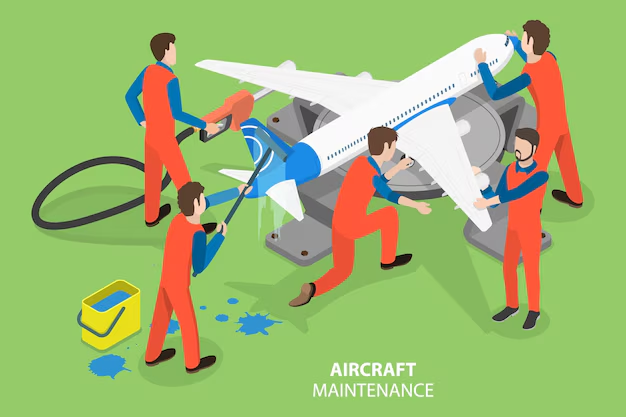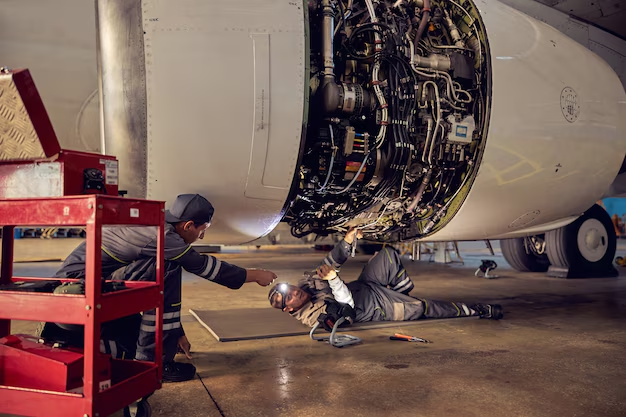In the rapidly evolving world of aviation, maintaining the operational efficiency and safety of aircraft is paramount. One of the critical elements in achieving this is the effective management of aircraft systems through reliable maintenance and diagnostics processes.
The ARINC (Aeronautical Radio, Incorporated) standards have played a crucial role in facilitating seamless communication and data exchange between various aircraft systems. Among these, ARINC 667 stands out as a significant standard that provides a robust framework for improving aircraft maintenance and diagnostics.
ARINC 667 is designed to enhance the interoperability and performance of integrated avionics systems, which are integral to modern aircraft. This standard streamlines the way maintenance personnel access, analyze, and diagnose data from various aircraft components, leading to more efficient troubleshooting, faster repairs, and ultimately, improved aircraft uptime.
By adopting ARINC 667, the aviation industry is able to achieve a higher level of standardization, reduce operational costs, and increase the accuracy of diagnostic procedures, all of which have a direct impact on the safety and reliability of the aircraft.
This article will explore the key ways in which ARINC 667 is transforming aircraft maintenance and diagnostics, highlighting its benefits, challenges, and future trends.

The Role of ARINC 667 in Aircraft Maintenance
ARINC 667 plays a pivotal role in modern aircraft maintenance by providing a standardized communication platform for avionics systems. Its primary function is to facilitate the exchange of critical data between various aircraft components and maintenance systems, enabling more efficient, accurate, and reliable maintenance procedures. The role of ARINC 667 in aircraft maintenance can be understood through several key aspects:

1. Enhanced Data Interoperability Across Systems
Aircraft today feature a diverse range of avionics systems, including navigation, communication, control, and monitoring systems, each often provided by different manufacturers. ARINC 667 ensures seamless interoperability among these systems by standardizing the data formats, protocols, and communication methods used to transmit diagnostic information. This standardization reduces the complexities that maintenance teams face when interacting with different system architectures, enabling a unified approach to data analysis.
2. Streamlining Maintenance Tasks Through Standardization
One of the most significant benefits of ARINC 667 is its ability to simplify maintenance workflows. By adopting a common data interface, maintenance personnel can access diagnostic information from multiple aircraft systems without needing to learn the specifics of each individual system’s data structure. This standardization reduces the time and effort required for data interpretation, leading to faster and more effective maintenance tasks.
3. Facilitating Real-Time Diagnostics and Data Logging
ARINC 667 supports real-time data logging and diagnostics, which are essential for proactive aircraft maintenance. By continuously monitoring system performance and capturing fault data, ARINC 667 enables maintenance teams to identify potential issues before they escalate into major failures. The ability to perform real-time diagnostics ensures that maintenance activities are more targeted and timely, ultimately improving aircraft availability and reducing the risk of unplanned downtime.
4. Simplifying Fault Isolation and Analysis
ARINC 667’s standardized diagnostic data makes it easier for maintenance personnel to isolate faults and analyze their root causes. With clear, structured data available, maintenance teams can quickly pinpoint where issues are occurring in the system, whether they relate to hardware malfunctions, software errors, or other operational anomalies. This enhances troubleshooting efficiency, reduces the need for extensive manual inspections, and helps resolve problems more accurately.
5. Improving Data Access for Maintenance Teams
With ARINC 667, maintenance teams gain easier access to historical and real-time data that can be used for both routine inspections and emergency diagnostics. This enables a more comprehensive understanding of an aircraft’s health and performance over time. By having all relevant diagnostic information readily available, maintenance personnel can make more informed decisions, ultimately improving the overall maintenance strategy and reducing the likelihood of oversight or errors.
Advantages of ARINC 667 for Diagnostics
ARINC 667 has transformed the way diagnostic processes are carried out in the aviation industry, offering several key advantages that enhance the effectiveness, speed, and accuracy of aircraft maintenance. The following are the primary advantages of ARINC 667 for diagnostics:

1. Improved Fault Detection and Isolation
One of the most significant advantages of ARINC 667 is its ability to enable rapid fault detection and isolation. By providing standardized and structured diagnostic data, ARINC 667 allows maintenance personnel to pinpoint the exact location of faults in the avionics systems. Whether the issue is related to hardware, software, or communication, the consistent data format helps identify problem areas quickly and accurately. This reduces the need for extensive troubleshooting and manual inspections, saving valuable time during the diagnostic process.
2. Faster Troubleshooting and Issue Resolution
The standardized diagnostic information provided by ARINC 667 allows maintenance teams to work more efficiently. Technicians no longer need to spend time deciphering complex and disparate data formats from various systems. With easy access to clear, readable fault codes and performance indicators, they can quickly understand the nature of the problem. This results in faster troubleshooting and quicker issue resolution, ensuring that aircraft can return to service with minimal downtime.
3. Enabling Predictive Maintenance
ARINC 667 contributes to the implementation of predictive maintenance strategies, which are essential for proactive aircraft fleet management. By continuously monitoring and logging data from critical aircraft systems, ARINC 667 helps identify trends and patterns that may indicate potential future failures. With access to this historical and real-time diagnostic data, maintenance teams can predict component failures before they occur and schedule maintenance accordingly. This predictive capability reduces unexpected breakdowns and optimizes the maintenance schedule, leading to reduced costs and improved aircraft availability.
4. Enhanced Accuracy of Diagnostics
The uniformity and precision of data provided by ARINC 667 ensures that diagnostic results are both accurate and reliable. Since all systems communicate using the same standard, there is a significant reduction in the risk of misinterpretation or errors that can occur when working with inconsistent data formats. This leads to more accurate diagnostics, fewer false alarms, and greater confidence in the findings, ultimately leading to better decision-making during the maintenance process.
5. Better Data Logging and Documentation
ARINC 667 facilitates detailed data logging, which is critical for maintaining a comprehensive history of diagnostic information over the lifecycle of an aircraft. This data can be used not only to troubleshoot current issues but also to identify recurring patterns or long-term trends that may point to systemic issues. The thorough documentation helps build a reliable maintenance record, which is useful for future diagnostic efforts and regulatory compliance, ensuring all maintenance work is accurately recorded and easily accessible.
6. Integration with Advanced Diagnostic Tools
ARINC 667’s structured data format allows it to be seamlessly integrated with advanced diagnostic tools, such as automated test equipment (ATE) and diagnostic software. These tools can process and analyze ARINC 667 data in real-time, offering additional insights into aircraft performance and identifying potential issues earlier. This integration supports more sophisticated diagnostics, helping maintenance teams detect complex problems that may not be immediately apparent through traditional methods.
7. Reduced Maintenance Costs
By improving the speed and accuracy of diagnostics, ARINC 667 helps reduce the overall cost of maintenance. Fewer man-hours are spent on troubleshooting, and the ability to conduct predictive maintenance minimizes the risk of costly unscheduled repairs. Additionally, the standardization of diagnostic processes ensures that maintenance teams can work more efficiently, requiring fewer specialized tools or training for different aircraft systems. This leads to significant savings in both time and money.
Impact on Maintenance Efficiency
The adoption of ARINC 667 has had a profound impact on the overall efficiency of aircraft maintenance processes. By streamlining communication and standardizing diagnostic data across various avionics systems, ARINC 667 has enabled significant improvements in how maintenance tasks are performed, reducing turnaround times, improving decision-making, and increasing the accuracy of maintenance efforts. The following points highlight the key impacts ARINC 667 has on maintenance efficiency:
1. Reduction in Maintenance Turnaround Times
One of the most direct impacts of ARINC 667 on maintenance efficiency is the reduction in turnaround times for aircraft repairs and maintenance. The standardization of data communication across avionics systems means that maintenance teams can access comprehensive diagnostic data quickly, eliminating the need to manually interface with each system to gather data. With real-time diagnostics, maintenance personnel can identify and address issues much faster, ensuring that aircraft spend less time on the ground and more time in the air. This streamlined workflow leads to reduced operational disruptions and improved fleet availability.
2. Minimizing Human Error
Maintenance tasks, especially in complex avionics systems, are prone to human error, particularly when technicians are required to interpret diverse and non-standardized data from different systems. ARINC 667 minimizes the risk of such errors by providing a unified, easy-to-understand format for all diagnostic information. With standardized data, maintenance personnel can more easily interpret results and make informed decisions without the confusion of multiple, inconsistent data sources. This reduction in human error results in fewer misdiagnosed issues, more accurate repairs, and ultimately, a safer and more efficient maintenance process.
3. Simplified Maintenance Processes
ARINC 667 simplifies the maintenance workflow by integrating and standardizing diagnostic data from various subsystems and components of the aircraft. Technicians no longer need to manually cross-reference data from different avionics systems or rely on a multitude of proprietary tools. With a unified data interface, the maintenance process becomes more straightforward, allowing technicians to quickly locate and resolve faults, reducing unnecessary steps and increasing efficiency. This simplification also allows for faster decision-making and more efficient use of maintenance resources.
4. Better Resource Allocation
The enhanced efficiency that ARINC 667 provides enables better resource management in the maintenance environment. Maintenance teams can allocate their time and effort more effectively, focusing on critical issues rather than spending time searching for or interpreting disparate data. Additionally, fewer resources are required for training, as the standardized interface allows technicians to work across different systems without needing extensive, system-specific training. This allows maintenance teams to operate more cohesively and with greater agility.
5. Streamlined Communication Across Teams
ARINC 667 facilitates smoother communication between maintenance teams, aircraft manufacturers, and even third-party service providers. Since all parties work with the same data standard, the flow of information is faster and more accurate. Technicians and engineers can easily collaborate, share diagnostic information, and make decisions based on consistent data, regardless of their location or area of expertise. This leads to quicker problem resolution and more coordinated maintenance efforts, ensuring that issues are addressed efficiently and effectively.
6. Improved Maintenance Scheduling
ARINC 667 also enhances maintenance scheduling by providing better insights into the health of various aircraft systems. Through real-time data monitoring and predictive maintenance capabilities, maintenance teams can identify potential issues before they become critical, allowing for better planning and scheduling of maintenance activities. This proactive approach reduces the likelihood of unexpected downtime, optimizes aircraft availability, and ensures that maintenance activities are completed in a timely and efficient manner, minimizing disruptions to flight schedules.
7. Long-Term Operational Efficiency
Over the long term, the use of ARINC 667 in aircraft maintenance results in sustained operational efficiency. The ability to predict maintenance needs and avoid unnecessary repairs or replacements helps to extend the lifespan of critical components and reduce overall maintenance costs. This operational efficiency also contributes to the overall safety and reliability of the aircraft, as timely and accurate maintenance ensures that all systems are functioning optimally.
Conclusion
In conclusion, ARINC 667 and related ARINC standards have revolutionized the aircraft maintenance and diagnostics landscape, enabling faster, safer, and more efficient operations across the aviation industry. By standardizing data communication, streamlining diagnostics, and minimizing human error, ARINC 667 has transformed maintenance practices and set a strong foundation for ongoing advancements. As a result, airlines and maintenance teams benefit from reduced turnaround times, improved resource allocation, and enhanced operational reliability.
Looking forward, the future of ARINC standards holds immense potential with the integration of emerging technologies like predictive analytics, IoT, digital twins, and AI. These innovations promise to elevate maintenance efficiency, allowing for real-time insights, proactive repairs, and advanced fleet management. As these trends continue to shape the industry, ARINC 667 and its successors will remain vital to achieving a more connected, intelligent, and sustainable approach to aircraft maintenance and diagnostics.







